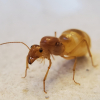- Formiculture.com
- Forums
- Gallery
- Members
- Member Map
- Chat

Argentine ants keeping
Started By
Jonny8040
, Aug 8 2020 11:38 AM
17 replies to this topic
#1
 Offline
-
Posted August 8 2020 - 11:38 AM
Offline
-
Posted August 8 2020 - 11:38 AM
Hey guys,
I’ve been doing a lot of research on Argentine ants and these little guys are everywhere near my house. Being extremely polygynous, could I collect a bunch of workers and a few queens, would they breed within their nest and have new queens or not? Has anybody had experience keeping these?
Thanks!
In Jesus,
Jonny
I’ve been doing a lot of research on Argentine ants and these little guys are everywhere near my house. Being extremely polygynous, could I collect a bunch of workers and a few queens, would they breed within their nest and have new queens or not? Has anybody had experience keeping these?
Thanks!
In Jesus,
Jonny
In Jesus,
Jonny
Jonny
#2
 Offline
-
Posted August 8 2020 - 12:55 PM
Offline
-
Posted August 8 2020 - 12:55 PM
Yeah you can probably have a large colony in no time. But they have been shown to not do that well in captive care.
#3
 Offline
-
Posted August 8 2020 - 1:11 PM
Offline
-
Posted August 8 2020 - 1:11 PM
Also you can’t release them as they are invasive, also only experienced ant keepers should take care of them. They can outgrow set-ups quickly and escape because of their numbers, they also are not best kept in captivity as SleepyAsianAnter said. Overall I would not recommend keeping them unless you have the space, time, food and water (which they need a lot of), and experience to keep. Also no, I don’t believe they inbreed, they need males to come from other nests to fly into their nest to mate with female alates.
Edited by TechAnt, August 8 2020 - 1:19 PM.
My Ants:
(x1) Campontous semitstaceus ~20 workers, 1 Queen
(x1) Camponotus vicinus ~10 workers, 1 Queen (all black variety)
(x1) Tetramorium immigrans ~100 workers, 1 Queen
(x1) Myrmercocystus mexicanus -1 Queen
(x2) Mymercocystus mimcus -1 Queen
(x1) Mymercocystus testaceus ~45 workers, 1 Queen
(x1) Campontous semitstaceus ~20 workers, 1 Queen
(x1) Camponotus vicinus ~10 workers, 1 Queen (all black variety)
(x1) Tetramorium immigrans ~100 workers, 1 Queen
(x1) Myrmercocystus mexicanus -1 Queen
(x2) Mymercocystus mimcus -1 Queen
(x1) Mymercocystus testaceus ~45 workers, 1 Queen
#4
 Offline
-
Posted August 8 2020 - 1:16 PM
Offline
-
Posted August 8 2020 - 1:16 PM
Are you certain you’re not seeing Tapinoma sessile? I really, really hope you’re not see Argentines everywhere. The two species look and act very similar.
- Antkid12 likes this
"The ants are a people not strong, yet they prepare their meat in the summer." Prov. 30:25
Keep ordinary ants in extraordinary ways.
Keep ordinary ants in extraordinary ways.
#5
 Offline
-
Posted August 8 2020 - 1:21 PM
Offline
-
Posted August 8 2020 - 1:21 PM
Yeah, you are likely seeing Tapinoma sessile. Do you have some pictures?
Ants I have: Tapinoma sessile(2 queen colony). RED MORPH Camponotus neacticus(now has pupae!), Tetramorium immigrans (x3), Aphaenogaster sp, Temnothorax sp, Brachymyrmex sp. possibly infertile ![]() , Ponera pennsylvanica, and Pheidole morrisi!
, Ponera pennsylvanica, and Pheidole morrisi! ![]()
Other insects: Polistes sp. Queen
Ants I need: Pheidole sp., Trachymyrmex sp., Crematogaster cerasi , Dorymyrmex sp. Most wanted: Pheidole morrisii
#6
 Offline
-
Posted August 8 2020 - 5:27 PM
Offline
-
Posted August 8 2020 - 5:27 PM
I don’t have any pictures at the moment but they are small ants that form huge trails like crazy with queens only a little bigger than the workers but clearly are queens.
In Jesus,
Jonny
Jonny
#7
 Offline
-
Posted August 8 2020 - 5:35 PM
Offline
-
Posted August 8 2020 - 5:35 PM
Most likely Tapinoma sessile. They’re doing the trail thing in my kitchen as I type.
"The ants are a people not strong, yet they prepare their meat in the summer." Prov. 30:25
Keep ordinary ants in extraordinary ways.
Keep ordinary ants in extraordinary ways.
#8
 Offline
-
Posted August 8 2020 - 5:37 PM
Offline
-
Posted August 8 2020 - 5:37 PM
Most likely Tapinoma sessile. They’re doing the trail thing in my kitchen as I type.
Haha 😆. After you said that I researched them and I heard that they breed withIn their nest with their own brothers. So technically, you could get a few queens and workers and start a massive super colony? With time of course?
In Jesus,
Jonny
Jonny
#9
 Offline
-
Posted August 8 2020 - 6:30 PM
Offline
-
Posted August 8 2020 - 6:30 PM
Yes, you could actually.Most likely Tapinoma sessile. They’re doing the trail thing in my kitchen as I type.
Haha . After you said that I researched them and I heard that they breed withIn their nest with their own brothers. So technically, you could get a few queens and workers and start a massive super colony? With time of course?
My Ants:
(x1) Campontous semitstaceus ~20 workers, 1 Queen
(x1) Camponotus vicinus ~10 workers, 1 Queen (all black variety)
(x1) Tetramorium immigrans ~100 workers, 1 Queen
(x1) Myrmercocystus mexicanus -1 Queen
(x2) Mymercocystus mimcus -1 Queen
(x1) Mymercocystus testaceus ~45 workers, 1 Queen
(x1) Campontous semitstaceus ~20 workers, 1 Queen
(x1) Camponotus vicinus ~10 workers, 1 Queen (all black variety)
(x1) Tetramorium immigrans ~100 workers, 1 Queen
(x1) Myrmercocystus mexicanus -1 Queen
(x2) Mymercocystus mimcus -1 Queen
(x1) Mymercocystus testaceus ~45 workers, 1 Queen
#10
 Offline
-
Posted August 8 2020 - 11:56 PM
Offline
-
Posted August 8 2020 - 11:56 PM
How to keep Argentine ants
Step one:
Find them
Step two:
Kill them
- RushmoreAnts and zantezaint like this
#11
 Offline
-
Posted August 9 2020 - 7:15 AM
Offline
-
Posted August 9 2020 - 7:15 AM
How to keep Argentine ants
Step one:
Find them
Step two:
Kill them
Step three:
For every colony killed, two more take its place.
- zantezaint likes this
"God made..... all the creatures that move along the ground according to their kinds (including ants). And God saw that it was good. Genesis 1:25 NIV version
Keeping:
Formica cf. pallidefulva, cf. incerta, cf. argentea
Formica cf. aserva, cf. subintegra
Myrmica sp.
Lasius neoniger, brevicornis
#12
 Offline
-
Posted August 9 2020 - 12:52 PM
Offline
-
Posted August 9 2020 - 12:52 PM
T sessile queens are near worker size, L. humile queens are maybe twice the size of workers.
#13
 Offline
-
Posted August 9 2020 - 1:08 PM
Offline
-
Posted August 9 2020 - 1:08 PM
How to keep Argentine ants
Step one:
Find them
Step two:
Kill themStep three:
For every colony killed, two more take its place.
Kinda true. But an extensive pest control operation really dents their numbers. Argentine ants aren't infinite, even they have a limit.
The owners of the area I live in, they've been spraying the Pheidole megacephala and Solenopsis invicta here for the past month or so (the entire complex they've sprayed). Every day, they spray in the morning and again in the evening, so its quite an operation. I think the apartment complex or whoever owns the land outside the complex discovered the invasive ants I reported. I dunno if it was my report itself cause I never got feedback on my report, but it does seem like they may been forced to act on the invasive ants. And this is during covid as well, and they are still spraying twice a day. It be nice if my report did something, but I dunno. At least after all this time they are doing something. I'm guessing they were forced to, but no idea.
They've also sprayed the entire area around a pond and along the river, not just inside the complex. And while the focus is probably on the Pheidole and S. invicta, this has made a massive decrease in Argentine ants. Enough where I've seen a native Solenopsis xyloni colony and a Pogonomyrmex sp. colony popup nearby. The area the native ants appeared in, used to be so dominated by Argentine ants that not even Solenopsis invicta or Pheidole megacephala together could take.
The Argentine ants will probably come back after some years, but there are huge areas where they are just completely gone and native ants are already returning.
Edited by Vendayn, August 9 2020 - 1:14 PM.
#14
 Offline
-
Posted August 9 2020 - 1:10 PM
Offline
-
Posted August 9 2020 - 1:10 PM
I wish my area would do that... all I have seen around here is one Camponotus spp. Worker and a dead Pheidole vistana queen which was being eaten by Argentines. Everything else was Argentines, Argentines, and Argentines.Kinda true. But an extensive pest control operation really dents their numbers. Argentine ants aren't infinite, even they have a limit.Step three:How to keep Argentine ants
Step one:
Find them
Step two:
Kill them
For every colony killed, two more take its place.
The owners of the area I live in, they've been spraying the Pheidole megacephala and Solenopsis invicta here for the past month or so (the entire complex they've sprayed). They've also sprayed the entire area around a pond and along the river. And while the focus is probably on the Pheidole and S. invicta, this has made a massive decrease in Argentine ants. Enough where I've seen a native Solenopsis xyloni colony and a Pogonomyrmex sp. colony popup nearby. The area they native ants appeared in, used to be so dominated by Argentine ants that not even Solenopsis invicta or Pheidole megacephala together could take.
The Argentine ants will probably come back after some years, but there are huge areas where they are just completely gone and native ants are already returning.
Edited by TechAnt, August 9 2020 - 1:11 PM.
My Ants:
(x1) Campontous semitstaceus ~20 workers, 1 Queen
(x1) Camponotus vicinus ~10 workers, 1 Queen (all black variety)
(x1) Tetramorium immigrans ~100 workers, 1 Queen
(x1) Myrmercocystus mexicanus -1 Queen
(x2) Mymercocystus mimcus -1 Queen
(x1) Mymercocystus testaceus ~45 workers, 1 Queen
(x1) Campontous semitstaceus ~20 workers, 1 Queen
(x1) Camponotus vicinus ~10 workers, 1 Queen (all black variety)
(x1) Tetramorium immigrans ~100 workers, 1 Queen
(x1) Myrmercocystus mexicanus -1 Queen
(x2) Mymercocystus mimcus -1 Queen
(x1) Mymercocystus testaceus ~45 workers, 1 Queen
#15
 Offline
-
Posted August 9 2020 - 1:24 PM
Offline
-
Posted August 9 2020 - 1:24 PM
I wish my area would do that... all I have seen around here is one Camponotus spp. Worker and a dead Pheidole vistana queen which was being eaten by Argentines. Everything else was Argentines, Argentines, and Argentines.
Kinda true. But an extensive pest control operation really dents their numbers. Argentine ants aren't infinite, even they have a limit.
Step three:How to keep Argentine ants
Step one:
Find them
Step two:
Kill them
For every colony killed, two more take its place.
The owners of the area I live in, they've been spraying the Pheidole megacephala and Solenopsis invicta here for the past month or so (the entire complex they've sprayed). They've also sprayed the entire area around a pond and along the river. And while the focus is probably on the Pheidole and S. invicta, this has made a massive decrease in Argentine ants. Enough where I've seen a native Solenopsis xyloni colony and a Pogonomyrmex sp. colony popup nearby. The area they native ants appeared in, used to be so dominated by Argentine ants that not even Solenopsis invicta or Pheidole megacephala together could take.
The Argentine ants will probably come back after some years, but there are huge areas where they are just completely gone and native ants are already returning.
I edited it in a bit late. But I think they must have got forced to. I dunno if my report on the Pheidole megacephala and Solenopsis invicta did anything, reported them last year and again months ago and never heard anything back. But even with covid going around, they are out every day spraying. I thought at first maybe it was because many garages and apartments got invaded by Pheidole megacephala, but they wouldn't spray outside the complex for that because its supposed to be a nature reserve. So I can only imagine someone IDed the invasive species and the apartments had to deal with it, since they are the same company who own the nature reserve. That or its because of what happened last year and it took them a long time to act on it (which is typical for a large company really). Last year, someones small dog died due to Solenopsis invicta, which was really sad.
But yeah. They spray twice a day (morning+evening), every day for over a month now for the entire area. I dunno how long they will keep doing it, but every day for over 30 days definitely made Argentine ants take a massive hit to their numbers. And the plus side, the Solenopsis invicta I can't find anymore, all their mounds are just empty or have dead ants. And the Pheidole megacephala are just gone. Though for some of it, the apartments also dropped water usage for landscaping by a huge amount. Which also made any ant reliant on moisture take a population drop (or just gone all together). And with how dry this Summer has been, that combination of things (less watering, pest control and super dry summer) might make a huge difference in this area in the shortterm.
I probably won't be here next year though, but we ended up stuck halfway in the moving process to covid, so I won't know most likely how things will be longterm here.
#16
 Offline
-
Posted August 9 2020 - 1:57 PM
Offline
-
Posted August 9 2020 - 1:57 PM
Tapinoma queens are not worker sized. They are at least double worker sized.T sessile queens are near worker size, L. humile queens are maybe twice the size of workers.
This Aus Ants video glorifying keeping these ants should be taken down.
- Antkid12 likes this
"The ants are a people not strong, yet they prepare their meat in the summer." Prov. 30:25
Keep ordinary ants in extraordinary ways.
Keep ordinary ants in extraordinary ways.
#17
 Offline
-
Posted August 9 2020 - 2:35 PM
Offline
-
Posted August 9 2020 - 2:35 PM
Sigh, he literally killed them after the video. He said he was going to freeze them.Tapinoma queens are not worker sized. They are at least double worker sized.T sessile queens are near worker size, L. humile queens are maybe twice the size of workers.
This Aus Ants video glorifying keeping these ants should be taken down.
- TechAnt likes this
#18
 Offline
-
Posted August 9 2020 - 3:32 PM
Offline
-
Posted August 9 2020 - 3:32 PM
And in another dimension, the ants are talking about how we are the invasive pests....
- Swirlysnowflake likes this
https://www.formicul...ale-california/
4 x Solenopsis xyloni (Fire ant) colonies.
2 x Veromessor andrei (Seed-harvester ant) colonies.
19 x Pogonomyrmex subnitidus (Seed-harvester ant) colonies + 3 x Pogonomyrmex (ID uncertain) colonies
16 x Linepithema humile (Argentine ant) colonies.
1 x Unknown Formicidae colony.
1 x Tapinoma sessile (Odorous house ant) colony.
1 x Camponotus fragilis (Carpenter/wood ant) colony + 1 x Camponotus sansabeanus (Carpenter/wood ant) colony.
1 x Solenopsis molesta (Thief ant) colony.
1 user(s) are reading this topic
0 members, 1 guests, 0 anonymous users























